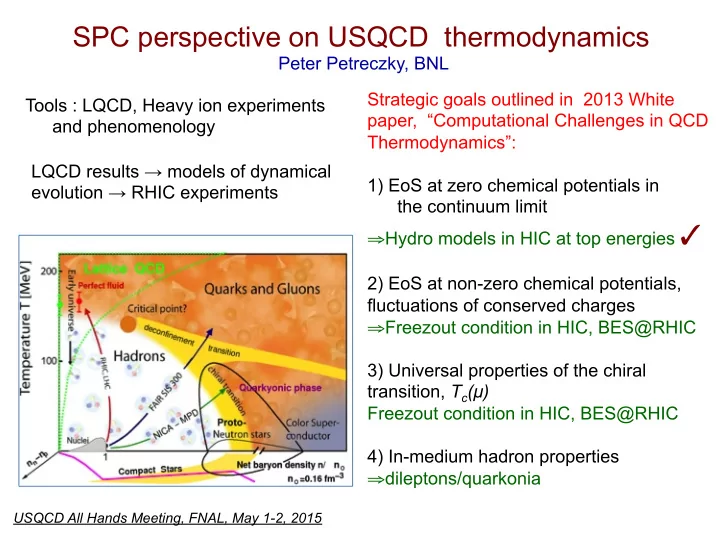

SPC perspective on USQCD thermodynamics Peter Petreczky, BNL Strategic goals outlined in 2013 White Tools : LQCD, Heavy ion experiments paper, “Computational Challenges in QCD and phenomenology Thermodynamics”: LQCD results → models of dynamical 1) EoS at zero chemical potentials in evolution → RHIC experiments the continuum limit ⇒ Hydro models in HIC at top energies ✓ 2) EoS at non-zero chemical potentials, fluctuations of conserved charges ⇒ Freezout condition in HIC, BES@RHIC 3) Universal properties of the chiral transition, T c (µ) Freezout condition in HIC, BES@RHIC 4) In-medium hadron properties ⇒ dileptons/quarkonia USQCD All Hands Meeting, FNAL, May 1-2, 2015
Physics of heavy ion collisions and LQCD Chiral transition, T c fluctu- high temperature QCD ations of conserved charges weak coupling ? EoS EM and heavy flavor probes test of Hadron Resonance Gas (HRG) using LQCD quarkonium spectral functions, heavy quark diffusion, thermal dileptons
Structure of thermo LQCD community and USQCD proposals MILC (HEP) LANL & LLNL staggered thermo non- USQCD resources HotQCD USQCD non-USQCD resources BNL (NP) USQCD resources non-USQCD resources International partners: Bielefeld University USQCD proposals in 2015 (time requested in M J/psi core h and GPU node h) : HotQCD (PI Karsch) Fluctuations : ALCF, zero priority 20%; Titan, 62.5M (15% of INCITE) BNL (PI P. Petreczky) Transition temperature for µ B >0 : Clusters, 57.3M (14%) BNL (PI S. Mukherjee) EoS at µ B >0 : GPUs 2.48M GPU hours (31%) BNL (PI H.-P. Schadler) High-T QNS: Clusters, 8.67M (2%)
Equation of state at zero baryon density Bazavov et al, PRD90 (2014) 094503 16 ( � -3p)/T 4 non-int. limit N � =8 N � =10 4 N � =12 12 cont HRG 3 T c HRG 8 3p/T 4 2 � /T 4 3s/4T 3 4 1 T [MeV] T [MeV] 0 0 130 170 210 250 290 330 370 130 170 210 250 290 330 370 Hadron resonance gas (HRG): T c = (154 ± 9)MeV Interacting gas of hadrons = non-interacting ✏ c ' 300MeV / fm 3 gas of hadrons and hadron resonances ( virial expansion, Prakash & Venugopalan ) ✏ low ' 180MeV / fm 3 ✏ nucl ' 150MeV / fm 3 HRG agrees with the lattice for T< 145 MeV ✏ high ' 500MeV / fm 3 ✏ proton ' 450MeV / fm 3
QCD thermodynamics at non-zero chemical potential Taylor expansion : Taylor expansion coefficients give the fluctuations and correlations of conserved charges, e.g. BES @ RHIC and freezout conditions can be done very efficiently on GPUs BNL-BI proposal (PI: PP) HotQCD proposal (PI: Karsch) T/T 0 1 m=o o LGT, m=0, O( µ 2 ) 0.8 HRG T f : J.Cleymans et. al. RHIC 200 GeV 0.6 RHIC 39 GeV RHIC 7.7 GeV 0.4 0.2 µ B /T 0 0 0 1 2 3 4 5 6 7 8 Need large N τ
Equation of state at zero baryon density Proposal by BNL-BI (PI:Mukherjee) Need high statistics but can be done for smaller N τ
What is the transition temperature ? Zero net baryon density, HotQCD: Bazavov et al, Phys. Rev. D85 (2012) 054503 H = m q /m s , h = H/h 0 , t = ( T − T c ) /T c /t 0 0 1 @ T − T c µ i µ j t = 1 X Non-zero baryon density: + A t 0 T c T i,j Curvature parameters are determined by the mixed susceptibility and scaling relation K = 2 κ q , κ qs , κ s Current estimates of the curvature do not agree: 0.059(5 ) (p4, scaling, BI-BNL, 2010), 0.059(18) (stout, Taylor, WB2011), 0.162(4) (HISQ, imag. µ, Cea et al, 2014 ), 0.117(27) (stout, imag. µ, Bonatti et al) Phenomenological Freezout curve: ~ 0.21(2)
Quark number fluctuations at high T At high temperatures quark number fluctuations can be described by weak coupling approach due to asymptotic freedom of QCD 2 nd order quark number fluctuations 4 th order quark number fluctuations 1.2 N � =6 � q 4 / � SB � q 2 / � SB 0.98 4 N � =8 2 1.1 N � =12 0.97 NLA 1 0.96 EQCD 3d pert. 0.9 0.95 0.8 0.94 3d pert. EQCD 0.7 0.93 LO HTLpt 0.6 0.92 0.5 0.91 T [MeV] T [MeV] 0.4 0.9 300 400 500 600 700 800 900 1000 300 400 500 600 700 800 900 1000 Bazavov et al, PRD88 (2013) 094021 • Good agreement between lattice and the weak coupling approach for 2 nd order quark number fluctuations • For 4 th order no continuum results => proposal by Schadler
In-medium meson properties No proposals this year on but progress is being made using configurations generated by HotQCD are being used for study meson spectral functions: Bazavov et al, Phys.Rev. D91 (2015) 5, 054503 Bazavov, Burnier, PP, arXiv:1404.4267 Kim, PP, Rothkopf, Phys.Rev. D91 (2015) 054511
Conclusions Lattice QCD starts to provide quantitative results that provide important input for interpreting the experimental results from HIC Main focus: T c , EoS, fluctuation of conserved charges at non-zero baryon density => RHIC BES II program SPC: When the results are needed ? They were due yesterday ! BES II is likely to happen in 2019/2020, phenomenological modeling is in progress and need input from lattice QCD now ⇒ BEST Topical Collaboration (PI : S. Mukherjee) In-medium meson properties (some progress) Relevant for heavy flavor program at RHIC (STAR upgrade, sPHENIX, ALICE, CMS) ⇒ Topical Collaboration for Heavy Flavor Probes of QGP (PI : R. Rapp, co-PI, P. Petreczky)
Recommend
More recommend